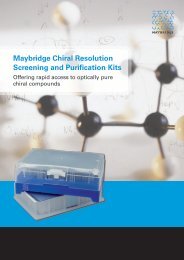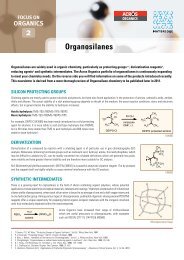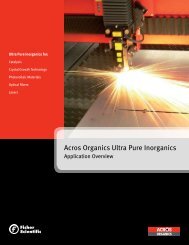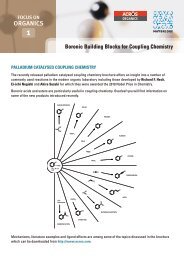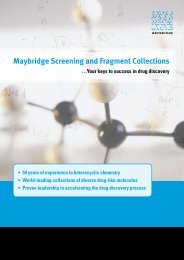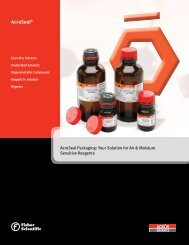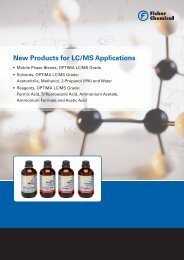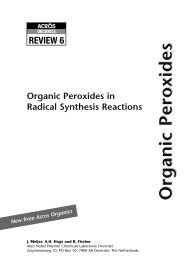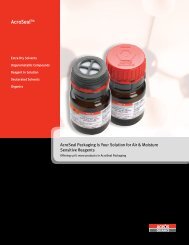Fisher Chemical
Fisher Chemical
Fisher Chemical
- No tags were found...
Create successful ePaper yourself
Turn your PDF publications into a flip-book with our unique Google optimized e-Paper software.
Molecular Biology | Enzymes (Modifying)Enzymes (Modifying) | Molecular BiologyCytosine-b-D-Arabinofuranoside HydrochlorideWhite PowderOPTIZYME Alkaline PhosphataseSource: Recombinant E. Coli StrainOPTIZYME DNase I, RNase-FreeSource: Recombinant E. Coli StrainOPTIZYME Klenow FragmentSource: Recombinant E. Coli StrainpackagingMfr. No100 mg AmberGlass BP2512-100500 mg AmberGlass BP2512-5005 g AmberGlass BP2512-510 g AmberGlass BP2512-10C 9 H 13 N 3 O 5 .HClCAS: 69-74-9MW: 279.67H317, H319, H361dP280, P281,P305+P351+P338FTIRConforms to standardMelting Point185°-195°COptical Rotation a 25 D+130° ± 5° (c=1, water)Tested forRNase activity, protease activity, and specific performance tests.UV/VIS: lambda max (H 2 O)280 ± 6nmApplications: Cytosine-b-D-Arabinofuranoside Hydrochloride inhibitsincorporation of labeled thymidine into DNA.Recommended Storage: 4°CNot on TSCA inventory: for R and D use only; not for manufacturing orcommercial purposes.Lysozyme, Egg WhiteWhite Crystalline PowderpackagingMfr. No1000 units Poly Tube BP8097-13000 units Poly Tube BP8097-5Tested forRNase activity, protease activity, and specific performance tests.Applications: Dephosphorylation of cloning vector DNA to preventrecircularization during ligation; PCR product clean-up: nucleotide degradationprior to sequencing of PCR product; Dephosphorylation of nucleic acid5’-termini prior to labeling with T4 Polynucleotide Kinase; Other applicationswhere dephosphorylation of DNA and RNA substrates is necessary; Proteindephosphorylation.Description: OPTIZYME Alkaline Phosphatase catalyzes the release of 5’- and3’- phosphate groups from DNA, RNA and both ribo- and deoxyribonucleosidetriphosphates. OPTIZYME Alkaline Phosphatase also removes phosphate groupsfrom proteins.Supplied With: 10X OPTIZYME AP Buffer (100mM Tris-HCl (pH 8.0 at 37°C),50mM MgCl2, 1M KCl, 0.2% (v/v) Triton X-100, 1 mg/mÒ BSA)Concentration: 1 u/µÒStorage Buffer Components: 20 mM HEPES-NaOH (pH 7.4), 1 mM MgCl2, 0.1mM ZnCl2, 0.1% (v/v) Triton X-100 and 50% (v/v) glycerol.Unit Definition: One unit is the amount of the enzyme required todephosphorylate 5’-termini of 1 µg of linearized pUC57 DNA in 10 min at 37°Cin OPTIZYME AP Buffer.Tested for: Endo-, exodeoxyribonuclease and ribonuclease-free; Functionallytested for dephosphorylation of 5’-termini of overhanging, recessed and bluntDNA.Recommended storage: -20°CpackagingMfr. No1000 units Poly Tube BP8107-1Tested forRNase activity, protease activity, and specific performance tests.Applications: Preparation of DNA-free RNA; Removal of template DNA followingin vitro transcription; Preparation of DNA-free RNA prior to RT-PCR andRT-qPCR; DNA labeling by nick-translation in conjunction with DNA PolymeraseI; Studies of DNA-protein interactions by DNase footprinting.Description: OPTIZYME DNase I, RNase-Free is an endonuclease that digestssingle- and double-stranded DNA. It hydrolyzes phosphodiester bondsproducing mono- and oligodeoxyribonucleotides with phosphate and OHgroups. The enzyme activity is strictly dependent on Ca2+ and is activated byMg2+ or Mn2+ ions: (1) In the presence of Mg2+, DNase I cleaves each strandof dsDNA independently, in a statistically random fashion; (2) In the presence ofMn2+, the enzyme cleaves both DNA strands at approximately the same site,producing DNA fragments with blunt ends or with one or two nucleotideoverhangs.Supplied With: 10X OPTIZYME DNase I Buffer (100mM Tris-HCl (pH 7.5 at25°C), 25mM MgCl2, 1mM CaCl2); 50mM OPTIZYME EDTAConcentration: 1u/µÒStorage Buffer Components: 50 mM Tris-HCl (pH 7.5), 10 mM CaCl2 and 50%(v/v) glycerol.Unit Definition: One unit of the enzyme completely degrades 1 µg of plasmidDNA in 10 min at 37°C. Enzyme activity is assayed in the following mixture: 10mM Tris-HCl (pH 7.5 at 25°C), 2.5 mM MgCl2, 0.1 mM CaCl2, 1 µg of pUC19DNA. One DNase I, RNase-Free unit is equivalent to 0.3 Kunitz unit.Tested for: Ribonuclease-free; Functionally tested for the digestion of templateDNA after in vitro transcription.Recommended storage: -20°CpackagingMfr. No300 units Poly Tube BP8106-11500 units Poly Tube BP8106-5Tested forRNase activity, protease activity, and specific performance tests.Applications: DNA blunting by fill-in of 5’-overhangs; Random-primed DNAlabeling; Labeling by fill-in 5’-overhangs of dsDNA; DNA sequencing by theSanger method; Site-specific mutagenesis of DNA with syntheticoligonucleotides; Second strand synthesis of cDNA.Description: OPTIZYME Klenow Fragment is the large fragment of DNAPolymerase I (E.coli). It exhibits 5’>3’ polymerase activity and 3’> 5’exonuclease (proofreading) activity, but lacks the 5’> 3’ exonuclease activity ofDNA Polymerase I.Supplied With: 10X OPTIZYME Klenow Fragment Buffer (500mM Tris-HCl (pH8.0 at 25°C), 50mM MgCl2, 10mM DTT).Concentration: 10u/µÒStorage Buffer Components: 25 mM Tris-HCl (pH 7.5), 0.1 mM EDTA, 1 mMDTT and 50% (v/v) glycerol.Unit Definition: One unit of the enzyme catalyzes the incorporation of 10 nmolof deoxyribonucleotides into a polynucleotide fraction (adsorbed on DE-81) in30 min at 37°C. Enzyme activity is assayed in the following mixture: 50 mMTris-HCl (pH 8.0 at 25°C), 5 mM MgCl2, 1 mM DTT, 0.033 mM dNTP, 0.4 MBq/mÒ -dTTP and 62.5 µg/mÒ activated salmon milt DNA.Tested for: Endodeoxyribonuclease-free; Functionally tested for fill in of5’-overhanging DNA termini and for random primed DNA labelingRecommended storage: -20°CpackagingMfr. No1 g AmberGlass BP535-15 g AmberGlass BP535-510 g AmberGlass BP535-1025 g AmberGlass BP535-25100 g AmberGlass BP535-100CAS: 12650-88-3EINECS: 235-747-3ActivitySalmonellaSolubilityTested forApprox. 20.000 units/mg proteinNone detectedPass testRNase activity, protease activity, and specific performance tests.Applications: This enzyme is used to lyse E. coli for preparation of plasmid DNAfrom transformed cell cultures.Recommended Storage: 3’ synthesis of DNA. The enzyme also exhibits 3’>5’exonuclease (proofreading) activity, 5’>3’ exonuclease activity and ribonucleaseH activity.Supplied With: 10X OPTIZYME DNA Pol I Buffer (500mM Tris-HCl (pH 7.5 at25°C), 100mM MgCl2, 10mM DTT).Concentration: 10u/µÒStorage Buffer Components: 25 mM Tris-HCl (pH 7.5), 0.1 mM EDTA, 1 mMDTT and 50% (v/v) glycerol.Unit Definition: One unit of the enzyme catalyzes the incorporation of 10 nmolof deoxyribonucleotides into a polynucleotide fraction (adsorbed on DE-81) in30 min at 37°C, using poly(dA-dT)·poly(dA-dT) as a template·primer. Enzymeactivity is assayed in the following mixture: 67 mM potassium phosphate (pH7.4), 6.7 mM MgCl2, 1 mM 2-mercaptoethanol, 0.033 mM dATP, 0.033 mMdTTP, 0.4 MBq/mÒ -dTTP and 62.5 µg/mÒ poly(dA-dT) poly(dA-dT).Tested for: Endodeoxyribonuclease-freeRecommended storage: -20°COPTIZYME Exonuclease IIISource: Recombinant E. Coli StrainpackagingMfr. No4000 units Poly Tube BP8108-1Tested forRNase activity, protease activity, and specific performance tests.Applications: Creation of unidirectional deletions in DNA fragments inconjunction with S1 Nuclease; Generation of a single-stranded template fordideoxy sequencing of DNA; Site-directed mutagenesis; Cloning of PCRproducts; Preparation of strand-specific probes.Description: OPTIZYME Exonuclease III exhibits four different catalyticactivities: (1) 3’>5’ exodeoxyribonuclease activity specific for double-strandedDNA. Exo III degrades dsDNA from blunt ends, 5’-overhangs or nicks, releasing5’-mononucleotides from the 3’-ends of DNA strands and producing stretchesof single stranded DNA. It is not active on 3’-overhang ends of DNA that are atleast four bases long and do not carry a 3’-terminal C-residue (onsingle-stranded DNA, or on phosphorothioate-linked nucleotides); (2)3’-phosphatase activity: Exo III removes the 3’-terminal phosphate andgenerates a 3’-OH group; (3) RNase H activity: Exo III exonucleolyticallydegrades the RNA strand in DNA-RNA hybrids; (4)Apurinic/apyrimidinic-endonuclease activity: Exo III cleaves phosphodiesterbonds at apurinic or apyrimidinic sites to produce 5’-termini that are base freedeoxyribose 5’-phosphate residues.Supplied With: 10X OPTIZYME ExoIII Buffer (660mM Tris-HCl (pH 8.0 at30°C), 6.6 mM MgCl2).Concentration: 200u/µÒStorage Buffer Components: 50 mM Tris-HCl (pH 8.0), 50 mM KCl, 1 mM DTTand 50% (v/v) glycerol.Unit Definition: One unit of the enzyme catalyzes the release of 1 nmol of acidsoluble reaction products from E.coli -DNA in 30 min at 37°C. Enzyme activity isassayed in the following mixture: 50 mM Tris-HCl (pH 8.0), 5 mM MgCl2, 1mM DTT and 0.05 mM sonicated E.coli -DNA.Tested for: Endodeoxyribonuclease-free; Functionally tested for the creation ofunidirectional deletions in DNA fragments.Recommended storage: -20°COPTIZYME M-MLV Reverse TranscriptaseSource: Recombinant E. Coli StrainpackagingMfr. No5000 units Poly Tube BP8104-125000 units Poly Tube BP8104-5Tested forRNase activity, protease activity, and specific performance tests.Applications: First strand cDNA synthesis for RT-PCR and real-time RT-PCR;Synthesis of cDNA for cloning and expression; Generation of labeled cDNAprobes for microarrays; DNA labeling; Analysis of RNA by primer extension.Description: OPTIZYME M-MLV Reverse Transcriptase possessesRNA-dependent and DNA-dependent polymerase activity and RNase H activityspecific to RNA in RNA-DNA hybrids, which is significantly lower than that ofAvian Myeloblastis Virus (AMV) reverse transcriptase. M-MLV RT activity isoptimal at 42°C (active up to 50°C). The enzyme is capable of both first strandcDNA synthesis (



